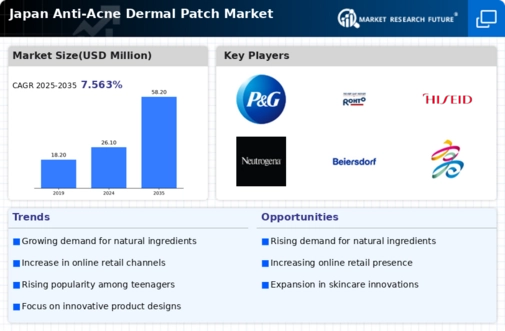Rising Influence of E-commerce
The expansion of e-commerce platforms in Japan is reshaping the retail landscape for the anti acne-dermal-patch market. With the convenience of online shopping, consumers can easily access a wide range of products, including specialized acne treatments. E-commerce sales in the beauty and personal care sector have surged, with a reported increase of 20% in online transactions over the past year. This shift allows brands to reach a broader audience and cater to niche markets, enhancing the visibility of anti acne-dermal patches. Additionally, online reviews and ratings play a crucial role in influencing purchasing decisions, as consumers rely on peer feedback when selecting skincare products. The growth of e-commerce is likely to continue driving sales in the anti acne-dermal-patch market, as more consumers opt for the convenience and variety offered by online retailers.
Cultural Shift Towards Self-Care
The cultural shift towards self-care and wellness in Japan is significantly impacting the anti acne-dermal-patch market. As individuals increasingly prioritize mental and physical well-being, skincare routines are being viewed as an essential aspect of self-care. This trend is reflected in the growing popularity of products that promote skin health, including anti acne-dermal patches. The market is witnessing a rise in consumers who view skincare not just as a necessity but as a form of self-expression and personal care. This cultural transformation is likely to drive demand for innovative and effective solutions in the anti acne-dermal-patch market, as consumers seek products that align with their self-care philosophies. The emphasis on holistic well-being suggests a promising future for the market, as it continues to evolve alongside changing consumer values.
Focus on Dermatological Research
The emphasis on dermatological research and development is a key driver for the anti acne-dermal-patch market. As scientific advancements continue to emerge, new formulations and technologies are being developed to enhance the effectiveness of acne treatments. Research institutions and skincare companies in Japan are increasingly collaborating to create innovative products that address various skin concerns. This focus on R&D is expected to lead to the introduction of advanced anti acne-dermal patches that incorporate active ingredients known for their efficacy. The potential for improved product performance may attract more consumers to the anti acne-dermal-patch market, as they seek solutions backed by scientific evidence. Furthermore, the integration of technology in product design could enhance user experience, further solidifying the market's growth.
Increasing Awareness of Skin Health
The growing awareness of skin health among consumers in Japan is a pivotal driver for the anti-acne dermal patch market. As individuals become more informed about skincare, they are increasingly seeking effective solutions for acne management. This trend is reflected in the rising sales of skincare products, with the market projected to reach approximately $3 billion by 2026. The anti acne-dermal-patch market benefits from this heightened awareness, as consumers actively search for targeted treatments that offer convenience and efficacy. Furthermore, educational campaigns by dermatologists and skincare brands contribute to this awareness, promoting the benefits of using patches as a non-invasive method to treat acne. This shift in consumer behavior indicates a potential for sustained growth in the anti acne-dermal-patch market, as more individuals prioritize their skin health and seek innovative solutions.
Shift Towards Convenience in Skincare
The increasing demand for convenience in skincare routines is significantly influencing the anti acne-dermal-patch market. Busy lifestyles in Japan lead consumers to prefer products that are easy to use and integrate into their daily routines. Anti acne-dermal patches offer a practical solution, allowing users to apply them discreetly and continue with their activities. This convenience factor is particularly appealing to younger demographics, who often seek quick and effective solutions for acne. Market data suggests that the convenience-driven segment of the skincare market is expected to grow by 15% annually, further propelling the anti acne-dermal-patch market. As consumers prioritize efficiency, the demand for such innovative products is likely to increase, indicating a robust growth trajectory for the anti acne-dermal-patch market.





















Leave a Comment